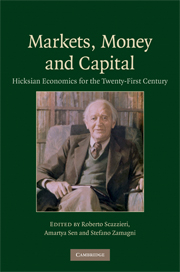Book contents
- Frontmatter
- Contents
- List of figures
- List of tables
- List of contributors
- Preface and acknowledgments
- Between theory and history: on the identity of Hicks's economics
- Part I The Intellectual Heritage of John Hicks
- Part II Markets
- Part III Money
- Part IV Capital and Dynamics
- 15 ‘Distribution and Economic Progress’ after seventy years
- 16 Flexible saving and economic growth
- 17 The economics of non-linear cycles
- 18 A perspective on a Hicksian non-linear theory of the trade cycle
- 19 Capital, growth, and production disequilibria: on the employment consequences of new technologies
- 20 Capital and time
- 21 Sequential analysis and out-of-equilibrium paths
- References
- Name index
- Subject index
20 - Capital and time
Published online by Cambridge University Press: 29 June 2009
- Frontmatter
- Contents
- List of figures
- List of tables
- List of contributors
- Preface and acknowledgments
- Between theory and history: on the identity of Hicks's economics
- Part I The Intellectual Heritage of John Hicks
- Part II Markets
- Part III Money
- Part IV Capital and Dynamics
- 15 ‘Distribution and Economic Progress’ after seventy years
- 16 Flexible saving and economic growth
- 17 The economics of non-linear cycles
- 18 A perspective on a Hicksian non-linear theory of the trade cycle
- 19 Capital, growth, and production disequilibria: on the employment consequences of new technologies
- 20 Capital and time
- 21 Sequential analysis and out-of-equilibrium paths
- References
- Name index
- Subject index
Summary
The time structure of decisions
‘My education has been mostly in the non-monetary parts of economics, and I have only come to be interested in money because I found that I could not keep it out of my non-monetary problems,’ John Hicks declares early on in his ‘A Suggestion for Simplifying the Theory of Money’ (Hicks, 1935a: 1). This is perhaps one of his most original publications, the foundation of several later Nobel Prizes, in particular that of Harry Markowitz. Already in that seminal paper, the time structure of decisions was prefigured: the ‘decision to hold money … is always made at a point of time’ (4). Hicks locates the critical problem in the ‘preference for holding money rather than capital goods’ (5). Then he announces the necessity of modeling money – or, rather, the riskiness of holding it – in a two-dimensional space: one has to specify a ‘mean value, and some appropriate measure of dispersion’ (8). Only ‘the appearance of … safe investments will act as a substitute for money,’ and ‘banks … are enabled to go further than other concerns in the creation of money substitutes’ (10). Finally, Hicks provides us with one of the main ideas of Keynes's The General Theory, a year before that work was published: ‘The whole problem of applying monetary theory is largely one of deducing changes in anticipations from the changes in objective data which call them forth’ (13).
- Type
- Chapter
- Information
- Markets, Money and CapitalHicksian Economics for the Twenty First Century, pp. 367 - 381Publisher: Cambridge University PressPrint publication year: 2009



